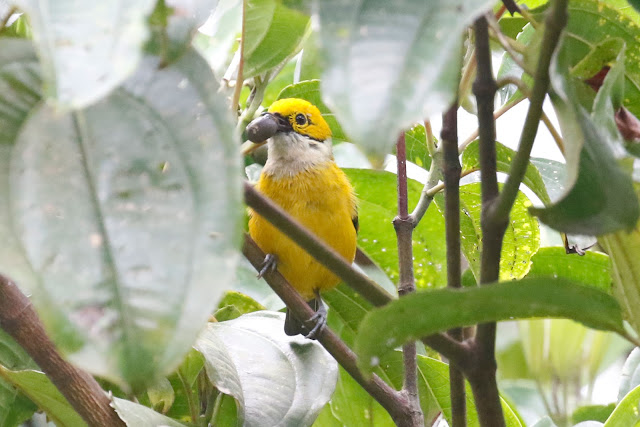It was damp underfoot following the morning downfall, but with the rain stopping the warmth returned and it became very humid. There were plenty of insects about, and who forgot the repellent today?
With the damp conditions there were several damselflies about using the large Banana leaves as resting points. This is the American Rubyspot, quite a common damselfly here.
As well as the damselflies there were more butterflies today, this one is a Long-tailed Skipper, minus the long tail
Here showing better the remnants of a tail, this one probably taken by a bird strike.
Despite the drab brown appearance it is a showy butterfly, with wings of light brown tinted
with iridescent blue when open, and two long tails extending from the hindwings. The
body is light blue at the top, but this varies in brightness. It has a large head, prominent eyes, and a
wingspan between 4.5 and 6 centimetres.
This one is more like the skippers we are used to back in the UK. Identification is not easy, potentially could be a Southern Skipperling.
This butterfly I have not been able to identify, the style and wing pattern being very similar to that of a Painted Lady.
This is a species of Daggerwing butterfly, settled on a Banana leaf.
This a species of Flasher, I think two-barred Flasher
While these two butterflies are possibly variants of the Apricot Sulphur
And finally another yellow butterfly that was smaller but I have not been able to identify despite the distinctive red markings on the tips of the wings.
The hummingbirds were about as well of course, the female Purple-throated Mountain Gem sitting on her usual perch.
But what I was hoping to find today was the Scintillant Hummingbird. I had brief views yesterday, but today I was able to work out what its territory was, its behaviour and where it went.
It is the smallest hummingbird within its range, which includes
only the mountains of Costa Rica and western Panama. This one of the smallest birds in the world, marginally bigger than the smallest the Bee Hummingbird found in Cuba.
The adult male Scintillant hummingbird has bronze-green upper-parts and a rufous and black-striped tail. The throat is brilliant orange,
separated from the cinnamon underparts by a white neck band. Small medallions of feathers catch the light to give the impression of a vivid orange necklace
The feeding approach was also different to the other hummingbirds, the Scintillant moving in amongst the bushes making it difficult to get a clear shot. You had to wait for it to move to the outside flowers.
It would then always return to the same spot, a branch hanging below a covering of leaves for shelter.
And while resting it would undergo same stretches and preening to keep in top condition.
It was now very warm, and with a little sun so we decided to head back to the villa, drop off some of our clothes, and then see if we could make the walk to the waterfalls. As we climbed the steps to the villa I found this hawkmoth just under some of the vegetation.
This is a Sphinx Moth, specifically Xylophanes anubis anubis. Found through out Central America, they are on the wing all year round. Strangely we found a moth on the deck five years ago when we were here, do the staff deliver them?
Standing on the deck of the villa there was considerable activity in the trees with several Tanagers moving through the branches taking small fruits. The most obvious was the Silver-throated Tanager, so called for the whitish colouring on the throat, but stood out for the yellow and black dominant plumage.
With the Silver-throated Tanagers were also a few Spangled-cheeked Tanagers. These species like to move around in flocks, and there were also Slate-throated Redstart, and woodpeckers that I couldn't see clearly to identify.Standing on the deck of the villa there was considerable activity in the trees with several Tanagers moving through the branches taking small fruits. The most obvious was the Silver-throated Tanager, so called for the whitish colouring on the throat, but stood out for the yellow and black dominant plumage.
We set off for the waterfalls but never made it, after about 400 metres the rains came and we had to turn back. The afternoon was spent between relaxing on the deck reading, and in the hot tub. While sitting in the hot tub I was taken by the patterns left in the leaves by the bugs that eat them. Against the silver grey sky they looked perfect in black and white.
As the rain eased and the clouds lifted we saw our first birds of prey, Black Vultures gathering together over the mountain sides high up in the sky.
Tomorrow we would move on, but as we knew we would be up early there would be plenty of time to have one more trip to the Hummingbird garden























No comments:
Post a Comment